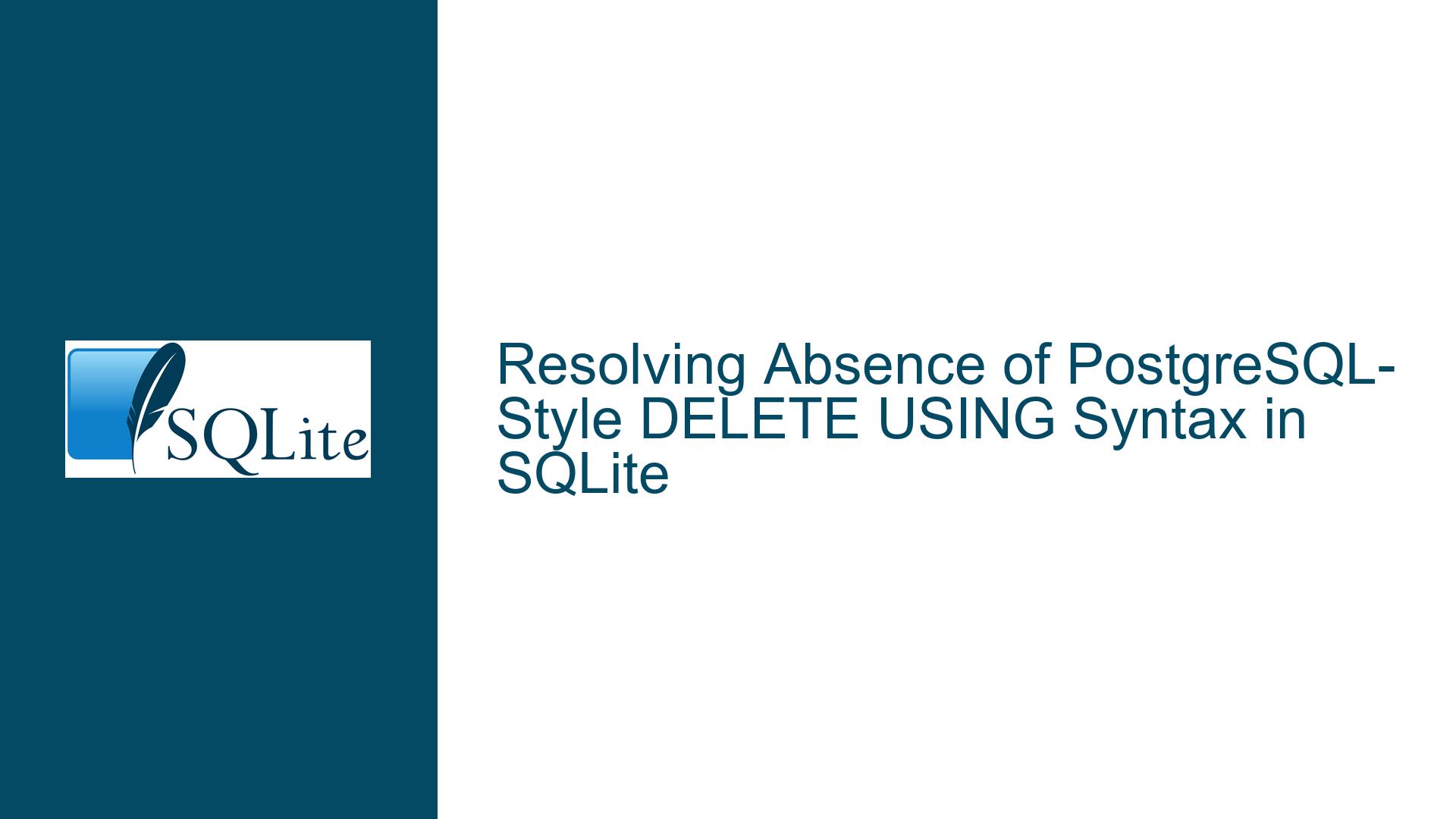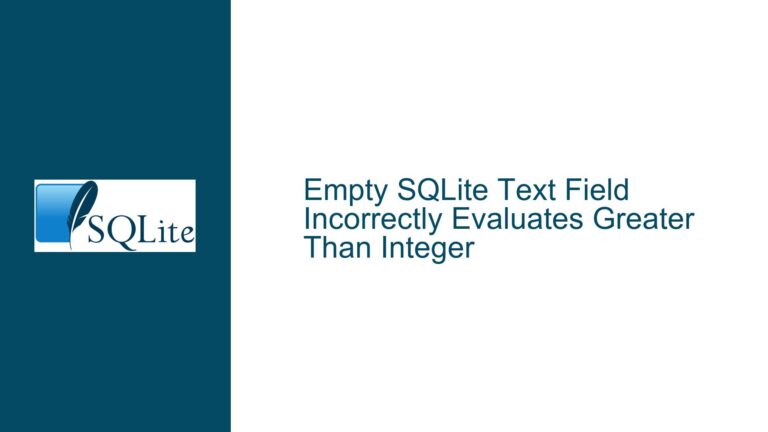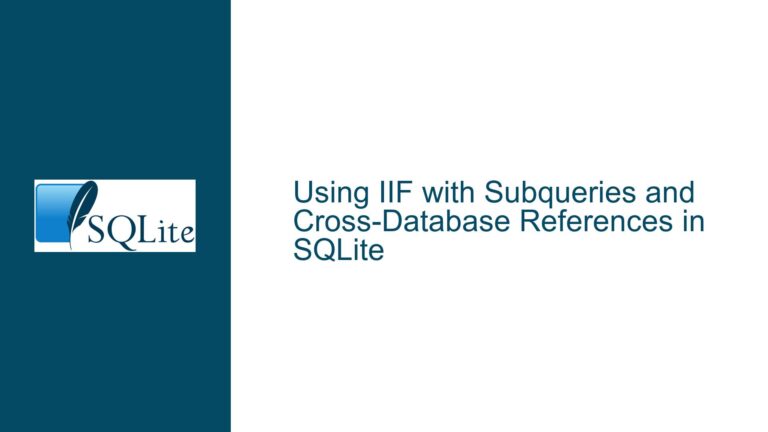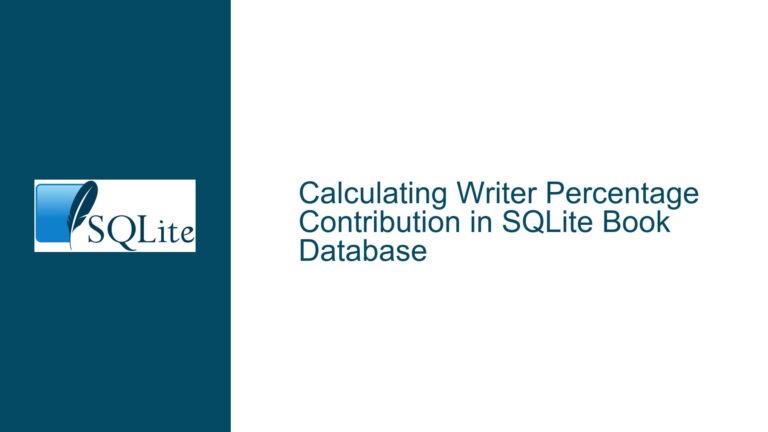Resolving Absence of PostgreSQL-Style DELETE USING Syntax in SQLite
Understanding the PostgreSQL DELETE USING Syntax and Its Functional Equivalence in SQLite
The PostgreSQL DELETE USING syntax provides a concise mechanism for performing deletions that involve multiple tables or complex join conditions. This construct allows developers to reference additional tables in the USING clause of a DELETE statement, enabling joins to be defined directly within the deletion logic. For example, deleting duplicate rows in a table by joining it against a subquery that identifies the duplicates becomes straightforward with this syntax. However, SQLite does not natively support the USING clause in DELETE statements, which has led to discussions about feature parity and alternative approaches.
In PostgreSQL, a typical DELETE USING operation might look like this:
DELETE FROM basket
USING (
SELECT id, MIN(rowid) AS min_rowid
FROM basket
GROUP BY id
HAVING COUNT(*) > 1
) AS duplicates
WHERE basket.id = duplicates.id
AND basket.rowid != duplicates.min_rowid;
This query deletes all duplicate rows in the basket table, retaining only the row with the smallest rowid for each id. The USING clause here references a subquery that identifies duplicates, and the WHERE clause defines the join condition between the target table and the subquery.
SQLite, in contrast, achieves the same outcome using Common Table Expressions (CTEs) and explicit subqueries. For instance:
WITH duplicates AS (
SELECT id, MIN(rowid) AS min_rowid
FROM basket
GROUP BY id
)
DELETE FROM basket
WHERE rowid NOT IN (SELECT min_rowid FROM duplicates);
This approach leverages SQLite’s support for CTEs to isolate the logic for identifying duplicates, followed by a DELETE operation that references the CTE. While functionally equivalent, this method requires a more verbose structure and a deeper understanding of SQLite’s rowid mechanics. The absence of DELETE USING in SQLite raises questions about syntactic ergonomics, developer familiarity, and the trade-offs between simplicity and expressiveness in database design.
Architectural and Design Rationale Behind SQLite’s Omission of DELETE USING
The lack of DELETE USING support in SQLite stems from three interrelated factors: adherence to SQL standards, architectural minimalism, and the availability of viable alternatives.
SQL Standard Compliance:
TheUSINGclause inDELETEstatements is not part of the SQL standard. PostgreSQL and DuckDB implement it as an extension, while SQLite prioritizes compliance with standard SQL where possible. For example, SQLite’sDELETEsyntax follows the ANSI SQL specification, which does not include aUSINGclause. This design choice ensures broader compatibility with applications that rely on standard SQL constructs.Parser and Lexer Constraints:
SQLite’s parser is intentionally lightweight to maintain portability and ease of embedding. Adding non-standard syntax likeDELETE USINGwould complicate the parser, potentially introducing edge cases or conflicts with existing features. PostgreSQL and DuckDB, which use more flexible parsers (DuckDB borrows PostgreSQL’s parser), can accommodate such extensions without destabilizing their codebases.Existence of Workarounds:
SQLite provides alternative mechanisms to achieve the same results asDELETE USING. Therowidpseudocolumn, CTEs, and subqueries enable developers to express complex deletion logic without requiring syntactic sugar. For instance, the following query deletes rows fromtableAthat have matching rows intableBwith a specific condition:DELETE FROM tableA WHERE EXISTS ( SELECT 1 FROM tableB WHERE tableA.id = tableB.a_id AND tableB.status = 'expired' );This approach uses a correlated subquery instead of an explicit join, achieving the same goal with standard SQL syntax. While less elegant than
DELETE USING, it remains functionally equivalent.Historical Precedent with UPDATE:
SQLite added support for aFROMclause inUPDATEstatements in version 3.33.0 (2020-08-14), allowing joins in update operations. This change was driven by developer demand and demonstrated that SQLite’s team is open to ergonomic improvements when they align with the project’s goals. However, extending this precedent toDELETEwould require a similar evaluation of utility versus complexity.
Implementing DELETE USING Logic in SQLite: Techniques, Examples, and Optimization
While SQLite lacks DELETE USING, developers can replicate its functionality using CTEs, subqueries, and joins. Below is a comprehensive guide to these techniques, including performance considerations and edge cases.
1. Common Table Expressions (CTEs) for Duplicate Removal
CTEs are ideal for breaking down complex deletion logic into modular steps. To delete duplicates while retaining the earliest rowid:
WITH retained_rows AS (
SELECT id, MIN(rowid) AS min_rowid
FROM basket
GROUP BY id
HAVING COUNT(*) > 1
)
DELETE FROM basket
WHERE rowid NOT IN (SELECT min_rowid FROM retained_rows);
- Advantages: Readable, self-documenting, and reusable for debugging.
- Pitfalls: Fails in
WITHOUT ROWIDtables, which lack therowidpseudocolumn. Use an explicit primary key instead.
2. Subquery Joins in WHERE Clauses
Correlated subqueries can emulate joins by referencing outer query columns:
DELETE FROM orders
WHERE EXISTS (
SELECT 1 FROM inventory
WHERE orders.product_id = inventory.product_id
AND inventory.stock = 0
);
- Use Case: Deleting orders for out-of-stock products.
- Optimization: Ensure
inventory.product_idis indexed to avoid full table scans.
3. Temporary Tables for Multi-Step Deletions
For very large datasets or multi-table operations, staging data in a temporary table improves performance:
CREATE TEMP TABLE to_delete AS
SELECT basket.rowid AS target_rowid
FROM basket
JOIN products ON basket.product_id = products.id
WHERE products.discontinued = 1;
DELETE FROM basket
WHERE rowid IN (SELECT target_rowid FROM to_delete);
- Advantages: Separates identification and deletion phases, reducing lock contention.
- Drawbacks: Requires additional storage and I/O overhead.
4. Leveraging UPDATE FROM Precedent
SQLite’s UPDATE FROM syntax suggests a blueprint for extending DELETE:
-- Hypothetical future syntax (not currently supported)
DELETE FROM basket
USING products
WHERE basket.product_id = products.id
AND products.discontinued = 1;
Developers advocating for this syntax can reference the UPDATE FROM feature as a precedent when submitting feature requests to the SQLite team.
5. Handling WITHOUT ROWID Tables
For tables without rowid, use explicit primary keys:
CREATE TABLE basket(
id INTEGER PRIMARY KEY,
fruit TEXT NOT NULL
) WITHOUT ROWID;
WITH retained_rows AS (
SELECT id, MIN(fruit) AS keep_fruit
FROM basket
GROUP BY id
HAVING COUNT(*) > 1
)
DELETE FROM basket
WHERE (id, fruit) NOT IN (SELECT id, keep_fruit FROM retained_rows);
- Key Insight: Composite primary keys or unique identifiers must replace
rowidin deletion logic.
6. Performance Tuning and Indexing
- Indexes: Ensure columns used in
JOIN,WHERE, orGROUP BYclauses are indexed. For thebasketexample, an index onidaccelerates the CTE:CREATE INDEX idx_basket_id ON basket(id); - ANALYZE Command: Run
ANALYZEperiodically to update statistics for the query planner. - Transaction Boundaries: Wrap large deletions in transactions to minimize I/O:
BEGIN; -- Deletion logic here COMMIT;
7. Edge Cases and Anti-Patterns
- Recursive Deletions: Avoid cascading deletions that trigger complex triggers or foreign key actions. Use
PRAGMA foreign_keys = OFF;cautiously. - Concurrency: SQLite’s write-ahead log (WAL) mode improves concurrency but does not eliminate table-level locks during writes.
By mastering these techniques, developers can achieve the same outcomes as PostgreSQL’s DELETE USING while adhering to SQLite’s design constraints. The decision to adopt these workarounds—or advocate for future syntax extensions—depends on project-specific needs for readability, performance, and maintainability.






